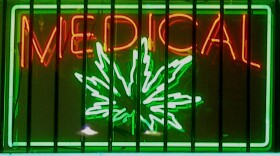While I was on the phone with a colleague from Denver last week, our conversation turned inevitably to the topic of marijuana. Colorado legalized recreational use of drug via popular referendum in 2012, creating the world's first fully regulated recreational marijuana market. The first commercial sales occurred this past January, with $15 million in sales reported in the first month alone.
Despite this, my friend patiently explained, the "Mile High City" isn't full of mile-high residents. Tight regulation of the market and increased spending on anti-drug messages, coupled with the drug-testing policies of private employers, makes it unlikely that most Coloradans will be 'passing the dutchie 'anytime soon.
While I don't smoke marijuana I do support the decriminalization of its recreational use. However, I suspect that few states will be following the lead of Colorado and Washington State anytime soon. More likely is the continued legalization of marijuana for medical use. Twenty states and the District of Columbia have laws that allow this. Fifteen other states are considering such legislation, including New York.
The Empire State is the only one in the Northeast without a medical marijuana law, but that may change soon. Governor Cuomo recently proposed reviving a defunct 1980 law -- the Controlled Substances Therapeutic Research Act -- that would allow marijuana's limited use. Under the proposed plan, the New York State Department of Health would oversee a program in which 20 hospitals will be allowed to prescribe marijuana as part of a pilot project to look at the drug as a treatment for life-threatening conditions like Dravet syndrome.
I find the Governor's proposal somewhat stupid. Legal and logistical problems aside, this limited program would add little to existing research on the safety and effectiveness of marijuana as a medical treatment. But at least it's a step in the right direction. If only the federal government were so open minded.
Not only has the US federal government has not passed a medical marijuana law, it still actively prosecutes those who grow, distribute or smoke marijuana. In 2013, for example, the US Department of Justice spent over $300 million investigating, arresting and prosecuting medical marijuana distributors.
Currently, the federal government regulates marijuana under the Controlled Substances Act of 1970. Drugs that fall under that Act are classified into one of five categories based on their potential for abuse and medicinal value. Marijuana is considered a Schedule 1 drug, the most dangerous and restrictive classification that exists. According to the US Drug Enforcement Agency (DEA), which enforces the Controlled Substances Act, marijuana has a high potential for abuse and no accepted medical use.
By contrast, the DEA considers cocaine to be a Schedule 2 drug. It is highly addictive, but it has been used as a topical anesthetic (particularly in the treatment of certain cancers). The prescription painkiller Oxycontin, which accounts for almost half of all drug overdose deaths in the United States, is also a Schedule 2 drug. Ketamine, an anesthetic that is also a commonly used 'date rape' drug, is a Schedule 3 drug. Alcohol and tobacco -- two highly addictive and widely abused drugs with no known medicinal benefit -- are not included in the DEA's schedules of controlled substances.
This doesn't make sense. Marijuana shouldn't be a Schedule 1 controlled substance. Consider the issue of addiction and abuse. One of the arguments against the legalization of marijuana -- either for medical purposes or for recreational use --- is that it is a so-called gateway drug. Opponents of legalization argue that people who smoke marijuana are more likely to abuse cocaine, heroin, or other illicit drugs.
That is not true. Decades of research into the addictive properties of marijuana have found scant evidence that the drug is more likely to be abused than a drug like Xanax. We've known this fact for years. A 1944 study conducted by the US National Academy of Science found no evidence that marijuana was physiologically addictive. While more recent studies suggest that some users can be psychologically hooked on its use, the risks of mental addiction to marijuana are far lower for other commonly used prescription drugs.
Questions of addiction aside, more troubling is the DEA's characterization of marijuana as a drug with no medicinal properties. That is patently false. Prior World War 2, in fact, marijuana was routinely prescribed in the US as a treatment for neuropathic pain. Moreover, hundreds of studies have demonstrated the benefits of the drug for treatment of pain and nausea in cancer and AIDS patients. The drug also helps control epileptic seizures and delays loss of vision in patients with glaucoma.
There are still some concerns about the long-term health effects of use marijuana -- particularly since the smoke also contains a variety of carcinogenic compounds -- but for people facing life-threatening or debilitating illness those risks are well worth the relief that marijuana provides.
It's time to change the federal approach to medical marijuana. There's no reason why marijuana is Schedule 1 controlled substance or why federal agents routinely shut down dispensaries that sell the drug to patients.
A public health researcher and ethicist by training, Dr. Sean Philpott is Director of Research Ethics for the Bioethics program at Union Graduate College-Icahn School of Medicine at Mount Sinai in Schenectady, New York. He is also Acting Director of Union Graduate College's Center for Bioethics and Clinical Leadership, and Project Director of its Advanced Certificate Program for Research Ethics in Central and Eastern Europe.
The views expressed by commentators are solely those of the authors. They do not necessarily reflect the views of this station or its management.




